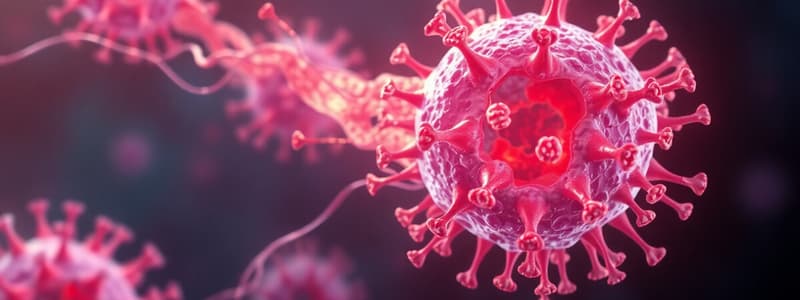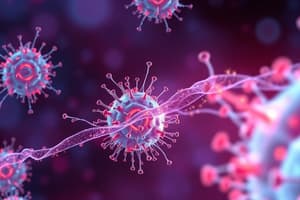Podcast
Questions and Answers
What is the primary role of cross-presentation by antigen-presenting cells?
What is the primary role of cross-presentation by antigen-presenting cells?
- To process and present extracellular antigens with MHC class I molecules to CD8 T cells. (correct)
- To present extracellular antigens to CD8 T cells using MHC class II molecules.
- To recognize and eliminate infected host cells.
- To enhance phagocytosis of extracellular pathogens.
Which of the following best describes the antigen receptors of the adaptive immune system?
Which of the following best describes the antigen receptors of the adaptive immune system?
- BCRs are membrane-bound monomeric immunoglobulins, while TCRs are heterodimers. (correct)
- B-cell receptors (BCRs) are dimers, while T-cell receptors (TCRs) are monomers.
- TCRs consist solely of Igα and Igβ heterodimers present on B cells.
- Both BCRs and TCRs are secreted proteins found in the bloodstream.
What are the components of the T-cell receptor (TCR) complex primarily composed of?
What are the components of the T-cell receptor (TCR) complex primarily composed of?
- One α chain and one β chain, with associated Igα and Igβ molecules. (correct)
- A single polypeptide chain combined with multiple immunoglobulin domains.
- Two heterodimers formed by α and β chains.
- Two identical α chains and one β chain.
What distinguishes αβ T-cell receptors from γδ T-cell receptors?
What distinguishes αβ T-cell receptors from γδ T-cell receptors?
What is the significance of dendritic cell maturation in the context of the adaptive immune response?
What is the significance of dendritic cell maturation in the context of the adaptive immune response?
Which of the following best distinguishes phagocytosis from macropinocytosis?
Which of the following best distinguishes phagocytosis from macropinocytosis?
What is the primary purpose of antigen processing and presentation?
What is the primary purpose of antigen processing and presentation?
Which statement accurately describes the steps of MHC I processing and presentation?
Which statement accurately describes the steps of MHC I processing and presentation?
How do MHC II molecules primarily acquire peptide fragments for presentation?
How do MHC II molecules primarily acquire peptide fragments for presentation?
What role does the invariant chain play in MHC II processing?
What role does the invariant chain play in MHC II processing?
What is a key feature of dendritic cell maturation for effective antigen presentation?
What is a key feature of dendritic cell maturation for effective antigen presentation?
What is the significance of cross-presentation in antigen processing?
What is the significance of cross-presentation in antigen processing?
In which situation would a peptide derived from an intracellular pathogen be loaded onto MHC II molecules?
In which situation would a peptide derived from an intracellular pathogen be loaded onto MHC II molecules?
What is the primary role of plasma cells that migrate to the bone marrow?
What is the primary role of plasma cells that migrate to the bone marrow?
How do MHC class I molecules differ from MHC class II molecules in their peptide transport mechanisms?
How do MHC class I molecules differ from MHC class II molecules in their peptide transport mechanisms?
Which of the following correctly describes the peptide-binding process for MHC class II?
Which of the following correctly describes the peptide-binding process for MHC class II?
Which of the following proteins is primarily involved in the assembly and peptide loading onto MHC class I molecules?
Which of the following proteins is primarily involved in the assembly and peptide loading onto MHC class I molecules?
What is the importance of cross-presentation in the immune system?
What is the importance of cross-presentation in the immune system?
Which statement best compares the structures of MHC class I and MHC class II molecules?
Which statement best compares the structures of MHC class I and MHC class II molecules?
What is a distinguishing feature of dendritic cell maturation?
What is a distinguishing feature of dendritic cell maturation?
In which compartment are proteins degraded into peptides for loading onto MHC class I molecules?
In which compartment are proteins degraded into peptides for loading onto MHC class I molecules?
Flashcards are hidden until you start studying
Study Notes
Adaptive Immune Receptors
- B cell receptors (BCRs) are monomeric immunoglobulins associated with disulfide-linked heterodimers called Igα and Igβ; located on the surface of B cells
- T cell receptors (TCRs) are heterodimers composed of either an αβ or a γδ chain pair; located on the surface of T cells
Immunoglobulin Structure
- Immunoglobulins (antibodies, BCRs, TCRs) have a basic structure comprising two heavy chains and two light chains linked by disulfide bonds.
T Cell Receptor Complex
- The TCR complex consists of the TCR, CD3 complex (CD3γ, CD3δ, CD3ε, and CD3ζ chains), and the ζζ homodimer
- TCR complex facilitates signaling upon antigen recognition
- TCR recognizes and binds to antigen presented by MHC molecules
T Cell Receptor Gene Rearrangement
- TCR genes undergo variable, diversity, and joining (VDJ) recombination to generate diverse TCR repertoires
- Rearrangement of gene segments leads to the formation of unique α and β chains, contributing to antigen specificity
αβ vs. γδ TCRs
- αβ TCRs recognize peptide antigens presented by MHC molecules
- γδ TCRs recognize a wider range of antigens, including non-peptide antigens and microbial stress signals
Antigen Processing and Presentation
- Antigen processing and presentation is the mechanism by which cells present fragments of antigens to T cells
- MHC class I presents intracellular antigens to CD8+ T cells, while MHC class II presents extracellular antigens to CD4+ T cells
MHC Class I Processing and Presentation
- MHC I molecules are loaded with peptides derived from intracellular proteins in the endoplasmic reticulum (ER)
- Peptides are transported into the ER lumen via the transporter associated with antigen processing (TAP)
- Peptide loading complex facilitates peptide binding to MHC I molecules
MHC Class II Processing and Presentation
- MHC II molecules are loaded with peptides from exogenous antigens captured via endocytosis
- Invariant chain blocks peptide binding within the ER
- Invariant chain is degraded within vesicles, leaving a fragment called CLIP, which is replaced by peptides
MHC Class I and Class II Differences
- MHC I is expressed on almost all nucleated cells, while MHC II is mainly expressed on antigen presenting cells (APCs)
- MHC I presents peptides from intracellular proteins, while MHC II presents peptides from extracellular proteins
Cross-Presentation
- Cross-presentation: the ability of certain cells, primarily dendritic cells, to present extracellular antigens on MHC class I molecules to CD8 T cells
- This enables the activation of cytotoxic T cells against extracellular pathogens that would not normally access the MHC class I processing pathway
Studying That Suits You
Use AI to generate personalized quizzes and flashcards to suit your learning preferences.




